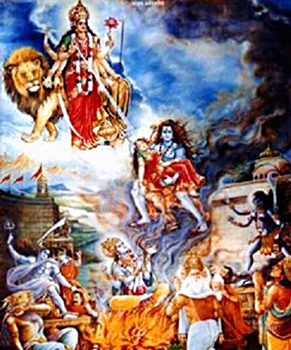 Brahma Purana states that Lord Shiva was infuriated as his wife Sati had been insulted and as a result he had destroyed the sacrifice which was organised by Daksha. According to the Purana the wonderful peak of Meru, Jyotihsthala is worshipped in the three worlds. It is adorned by precious jewels. The peak is incomprehensible, and bowed to by the people. Formerly, the lord was seated there on the ridge of the mountain wonderfully beautified by all sorts of minerals. He shone well and was as comfortable as he was seated in a palanquin. The daughter of the lord of the mountains stood away by his side.
Brahma Purana states that Lord Shiva was infuriated as his wife Sati had been insulted and as a result he had destroyed the sacrifice which was organised by Daksha. According to the Purana the wonderful peak of Meru, Jyotihsthala is worshipped in the three worlds. It is adorned by precious jewels. The peak is incomprehensible, and bowed to by the people. Formerly, the lord was seated there on the ridge of the mountain wonderfully beautified by all sorts of minerals. He shone well and was as comfortable as he was seated in a palanquin. The daughter of the lord of the mountains stood away by his side.
As the legend goes it says that when Daksha got ready for the sacrifice all the Devas started coming in for the sacrifice ceremony. It is said that led by Indra, Devas came from their heavenly abodes to his sacrifice at Gangadvara. The Gangadvara was thronged by Gandharvas and Apsaras. It abounded in trees and creepers. Daksa the most excellent among the virtuous ones was surrounded by groups of sages.
The residents of the Earth, firmament and heavenly world joined their palms in reverence and stood near him. The Adityas, Vasus, Rudras, Sadhyas, Maruts and Lord Vishnu came there to partake of their shares in the sacrifice. The excellent Devas, Ajyapas, Somapas, Asvins, Maruts and different groups of Devas came there. These and other congregations of living beings, the four species of living organisms had also come for the sacrifice ceremony.
It has been mentioned in the Purana that Dhadichi had asked Daksha as to why Lord Shiva was not present in the sacrifice ceremony. At this Daksha had said that he had eleven Rudras of his own who resides in the eleven abodes and he does not recognise any Mahaeshwara besides them.
Brahma Purana states as to how Uma was agitated that her husband was not invited in the horse sacrifice which Daksha was performing. At such a reaction from his wife Lord Shiva created a goblin from his mouth. He told the goblin to go and immediately destroy the holy rites which was being organised by Daksha.
That goblin knew that Daksa was the cause of Uma`s indignation. Hence, he destroyed the sacrifice of Daksa playfully. This he did by the order of Rudra to assume the form of a lion. In fact, the goblin was the lord himself, who assumed the form of the fury of the lord and took up his abode in the cremation ground, the resting place of ghosts. He is known as Virabhadra. Eventually he wiped off indignation and sorrow of his consort Uma. It is said that from the pores of his bodily hairs he himself created some leading Ganas, the terrible followers who had virility and exploit akin to that of Rudra himself. These Ganas produced tumultuous sound that filled the entire environment. The heaven-dwellers were frightened by that loud tumult. The mountains crumbled down and the earth quaked. Gusts of wind blew ruthlessly. The abode of ocean became stirred up and excited. Fires did not blaze nor did the sun shine. The ritual vessels were broken to pieces and reduced to powder. The sacrificial chambers crumbling down appeared like the stars fallen from the sky. Various sorts of foodstuffs and beverages were swallowed and lapped by the goblins. Those gigantic beings towering high like mountains agitated and terrified everyone everywhere. The Ganas quickly burned that sacrifice well-guarded by all Devas. They burned it up in the presence of Bhadrakali. The others produced loud crying sounds that frightened all living beings.
Finally the situation was such that the entire sacrifice of the arrogant Daksa was harassed by the Ganas. Thus harassed the sacrifice assumed the form of a deer and jumped high into the sky. At last Lord Shiva appeared and Daksha sought refuge in the lord. Daksha prayed to the lord and all boons were granted to him by the lord.



















